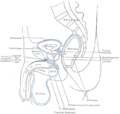Layers
The peritoneum is one continuous sheet, forming two layers and a potential space between them: the peritoneal cavity.
The outer layer, the parietal peritoneum, is attached to the abdominal wall and the pelvic walls. [1] The tunica vaginalis, the serous membrane covering the male testis, is derived from the vaginal process, an outpouching of the parietal peritoneum.
The inner layer, the visceral peritoneum, is wrapped around the visceral organs, located inside the intraperitoneal space for protection. It is thinner than the parietal peritoneum. The mesentery is a double layer of visceral peritoneum that attaches to the gastrointestinal tract. There are often blood vessels, nerves, and other structures between these layers. The space between these two layers is technically outside of the peritoneal sac, and thus not in the peritoneal cavity.
The potential space between these two layers is the peritoneal cavity, filled with a small amount (about 50 mL) of slippery serous fluid that allows the two layers to slide freely over each other.
The right paracolic gutter is continuous with the right and left subhepatic spaces. The epiploic foramen allows communication between the greater sac and the lesser sac. [2] The peritoneal space in males is closed, while the peritoneal space in females is continuous with the extraperitoneal pelvis through openings of the fallopian tubes, the uterus, and the vagina. [3]
Classification of abdominal structures
The structures in the abdomen are classified as intraperitoneal, mesoperitoneal, retroperitoneal or infraperitoneal depending on whether they are covered with visceral peritoneum and whether they are attached by mesenteries (mensentery, mesocolon).
| Intraperitoneal | Mesoperitoneal | Retroperitoneal ( or Extraperitoneal ) | Infraperitoneal / Subperitoneal |
| Stomach, half of the first part of the duodenum [2.2 cm], jejunum, ileum, cecum, appendix, transverse colon, sigmoid colon, rectum (upper 1/3) | | The rest of the duodenum, ascending colon, descending colon, rectum (middle 1/3) | Rectum (lower 1/3) |
| Spleen, pancreas (only tail) | Liver | Pancreas (except tail) | |
| | Kidneys, adrenal glands, proximal ureters, renal vessels | Urinary bladder, distal ureters |
| In women: ovaries | | | Gonadal blood vessels, Uterus, Fallopian Tubes |
| | Inferior vena cava, aorta | |
Structures that are intraperitoneal are generally mobile, while those that are retroperitoneal are relatively fixed in their location.
Some structures, such as the kidneys, are "primarily retroperitoneal", while others such as the majority of the duodenum, are "secondarily retroperitoneal", meaning that structure developed intraperitoneally but lost its mesentery and thus became retroperitoneal.
Development
The peritoneum develops ultimately from the mesoderm of the trilaminar embryo. As the mesoderm differentiates, one region known as the lateral plate mesoderm splits to form two layers separated by an intraembryonic coelom. These two layers develop later into the visceral and parietal layers found in all serous cavities, including the peritoneum.
As an embryo develops, the various abdominal organs grow into the abdominal cavity from structures in the abdominal wall. In this process they become enveloped in a layer of peritoneum. The growing organs "take their blood vessels with them" from the abdominal wall, and these blood vessels become covered by peritoneum, forming a mesentery. [6]
Peritoneal folds develop from the ventral and dorsal mesentery of the embryo. [4]








